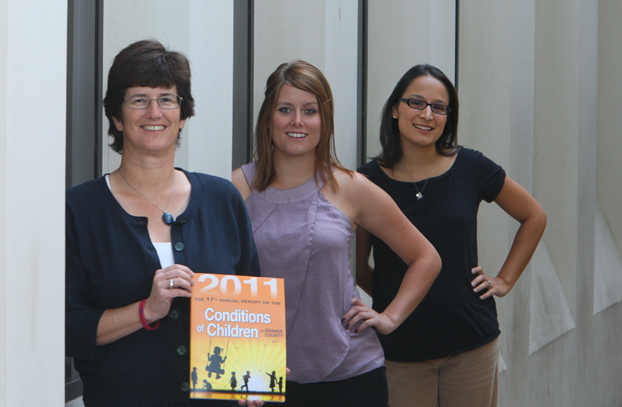 Caption: From left: Michelle G. Berelowitz, Alicia Recob and Marta Ortegon Davis. Photo by Karen Tapia Download Photo
Caption: From left: Michelle G. Berelowitz, Alicia Recob and Marta Ortegon Davis. Photo by Karen Tapia Download Photo
Poverty Climbs, Reading Declines
Report Finds Low Test Scores Connected to Economy
As families throughout Orange County struggle economically, more children are qualifying for welfare services and free or reduced-price school lunches, and their reading scores are plummeting, according to the 17th annual Report on the Conditions of Children in Orange County.
Community Forum: Nov. 16
The 10th annual Community Forum on
the Conditions of Children in Orange
County will he held Wednesday,
Nov. 16.
Scheduled from 7:30 a.m. to noon in
the Titan Student Union, the forum is
free and open to the public.
The Community Forum is a discussion
about the implications of the 17th
annual Report on the Conditions of
Children, which tracks 40 indicators of
the well-being of children in four major
areas:
• Good Health
• Economic Well-Being
• Educational Achievement
• Safe Homes and Communities
The keynote speaker will be Los
Angeles Superior Court Judge Yvette
Verastegui.
To register for the forum,
visit http://ccr2011.eventbrite.com
or call the Orangewood Children’s
Foundation at 714-704-8777.
While school districts in affluent neighborhoods are seeing children's reading scores soar, kids in low-income neighborhoods are going in the opposite direction, the report found.
For example, the average reading score on a standard state test of fourth-graders in Santa Ana was 360, while the average score in Los Alamitos was 424 and 411 in Huntington Beach.
A score above 400 is considered high, and the county’s goal was to average 400, said Michelle G. Berelowitz, director of Cal State Fullerton’s Center for Community Collaboration. The center and the Orangewood Children’s Foundation produced the report, which is sponsored by the county of Orange and the Children and Families Commission of Orange County.
“We’re seeing an increase in poverty with 45 percent of school children now qualifying for free or reduced-price lunch,” she said. “The correlation between low family income and low test scores is getting stronger. The poorer you are, the less likely you'll do well on the state tests. This is cause for concern.”
When parents “are worried about finding jobs and how they will feed their families,” Berelowitz said, “it’s hard to be involved in their children's success at school.”
In Orange County, “we have seen an increase in the percent of students receiving free and reduced lunch, which means more kids are in poverty,” she added. “However, we have also seen an increase in all the county schools’ test scores. Therefore, the schools have been responding to the needs of the lower income families and the free and reduced lunch program is an intervention that can help children have proper nutrition while in school.”
Besides the test score findings, the 208-page report is packed with statistics on the health, economic status, safety and education of Orange County's children. Agencies throughout the county use it to spot trends and determine what can be done to improve children's lives.
Among the findings in this year’s report:
- Child abuse reports increased 2.6 percent from 37,015 in 2004 to 37,977 in 2010.
- Students receiving free or reduced-price school lunches reached 45 percent, or 228,121 students, last year.
- The 2010-2011 average-per-pupil expenditure for grades K-12 was $7,852 for Orange County, compared to $8,846 for California and $10,586 for the United States.
On the positive side are these findings:
- The number of teenagers giving birth dropped 38 percent since 2000.
- Juvenile arrests dropped 7.6 percent from 15,528 in 2000 to 14,345 in 2009.
- The number of youths between the ages of 8 and 17 who joined Orange County gangs dropped to 1,624 in 2010 from the 1,851 who joined gangs in 2009.
The report includes a special section on the impact of domestic and family violence on children.
“Children who witness family violence suffer many of the same physical and psychological effects as those who are the direct recipients of abuse,” according to the report. “On average in Orange County, 111 reports of child abuse are made each day. In 2010, 23 deaths related to domestic violence were reported.”
The report recommends early identification of domestic violence, followed by intervention, which can help decrease the impact on children exposed to abuse.
Addressing the need to mitigate the impact of domestic violence on children will be the topic of the keynote address by Los Angeles Superior Court Judge Yvette Verastegui at the 10th annual Community Forum on the Conditions of Children in Orange County, which will take place Nov. 16 on campus.
The rest of the report also will be discussed at the forum by the heads of the county’s social service agencies. In addition, Berelowitz will provide an overview of the report. Her PowerPoint presentation is available for download.
More than 500 educators, community leaders and representatives of human service groups and law enforcement agencies are expected to attend the forum.
Those who attend say the report spots trends and helps them create needed services for the county's children.
“It never ceases to amaze me how innovative Orange County is in developing and implementing programs to benefit children,” based on needs surfaced through the report, said Marta Ortegon Davis (B.A. psychology ’00), a human services lecturer who has been working on the annual report for each of the past five years.
To obtain a free copy of the book, call the Center for Community Collaboration at 657-278-5681.
Nov. 4, 2011
 By
By  Victoria M. Garcia (B.S. human services ’06, M.S. counseling ’10), project manager of the Report on the Conditions of Children: “I learned about the Center for Community Collaboration and the Conditions of Children report through Michelle Berelowitz when I was in her class as a student. I was hired on as an intern research assistant in 2005. Since then, I have worked my way up to project manager of the report and function as the liaison between the county data contacts in making sure all the data is received and input into the report you see every year. Working for the center on this project has brought me opportunities I never would have imagined. I am in constant contact with county officials, networking on multiple levels. And, I am well-informed and updated on what is going on in Orange County. Along with the report, I have served on multiple projects with Michelle and assisted her in working with nonprofit organizations throughout the county, evaluating their programs. I never saw myself in research and yet, it is all around me, and I am constantly fascinated by the information I learn.”
Victoria M. Garcia (B.S. human services ’06, M.S. counseling ’10), project manager of the Report on the Conditions of Children: “I learned about the Center for Community Collaboration and the Conditions of Children report through Michelle Berelowitz when I was in her class as a student. I was hired on as an intern research assistant in 2005. Since then, I have worked my way up to project manager of the report and function as the liaison between the county data contacts in making sure all the data is received and input into the report you see every year. Working for the center on this project has brought me opportunities I never would have imagined. I am in constant contact with county officials, networking on multiple levels. And, I am well-informed and updated on what is going on in Orange County. Along with the report, I have served on multiple projects with Michelle and assisted her in working with nonprofit organizations throughout the county, evaluating their programs. I never saw myself in research and yet, it is all around me, and I am constantly fascinated by the information I learn.”